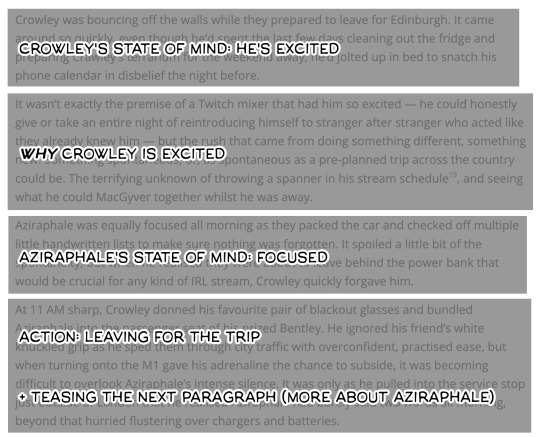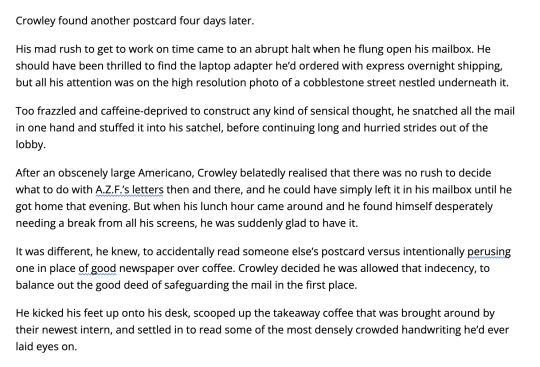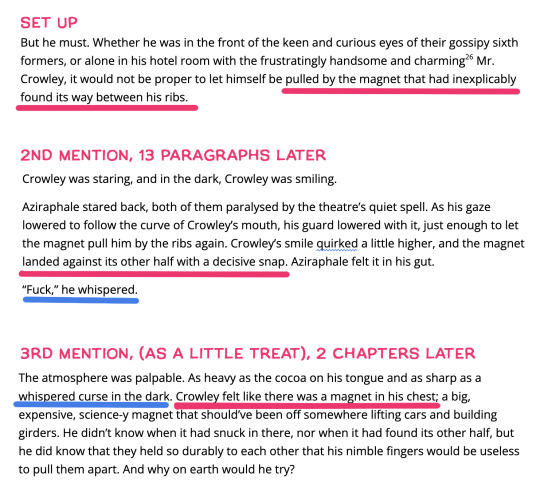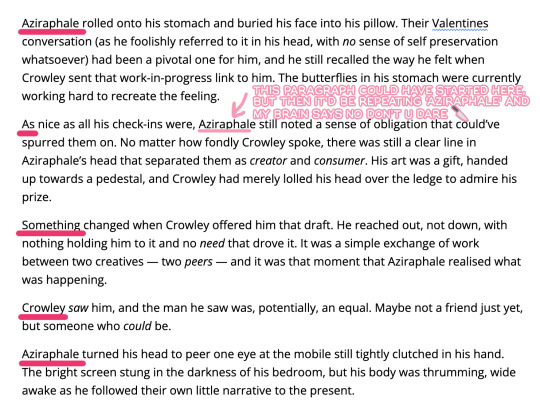#includes some bnf teasers :)
Text
some tips for writing flow
i've had a lot of comments complimenting my writing style, most of which don't know how to explain or describe what they like about it. i never really knew either, but i've been paying more attention to the way i write things lately, in the hope of being able to understand and explain it.
a lot of this is "based on feel" with no hard and fast rules, but there's also very tangible techniques you can hopefully work into your own writing, if that makes sense? idk is this anything—
1 - sentence beats, and alternating them.
this is probably the biggest thing in my writing. i've realised my sentences can be measured in beats, based on their length and how many sections they can be broken into. the pattern changes often, and i don't have a concrete rule in how i fill a paragraph (again, i've only just put words to any of this), but it's probably the most important part of my flow. let's have a look:
1 beat:
• this is probably the biggest thing in my writing.
2 beats:
• i've realised my sentences can be measured in beats
• based on their length and how many sections they can be broken into.
3 beats:
• the pattern changes often
• and i don't have a concrete rule in how i fill a paragraph
• but it's probably the most important part of my flow.
it looks like a favour certain patterns, the only real "rule" i use is to construct a paragraph with various beats, and never put two side by side. whenever i'm struggling with my flow, it's usually because i've put two of the same beats next to each other and everything feels either stiff or crowded. i rarely put two side by side, unless it's for specific emphasis.
the other exception are paragraph breaks: these are a pause for breath, and allow us to reset the pattern. i often start and end my paragraphs with single beat sentences, and it doesn't feel like they're running on because there's that lovely breath between them.
2 - short paragraphs
the rule we learn in school is that new paragraphs are for new ideas. convert this to prose, and we can consider "ideas" to include the character's thoughts, new narrative tangents, and physical movement around a scene.
one of my biggest struggles reading "bad" fanfic is when paragraphs are too lumped together. crowley will walk into the bookshop, see aziraphale across the way, wander over to a shelf, select a book, then pour himself a drink all in one big chunk. i can't parse that. there doesn't have to be a new line break for every new action, but grouping the relevant ones together and breaking in between broad motions (i.e. walking across a room, acknowledging a character) can help ease readers through the scene.


paragraphs are a breath, not only for sentence flow, but for processing the action within a story. similarly, purposefully keeping multiple actions confined to a single paragraph can make them feel quicker, while breaking them up into multiple paragraphs will slow down the pacing (even if the amount of detail describing each action is the same). included some examples because i'm struggling to explain this one


3 - mixing metaphors
this might sound less flow related, but i used to struggle with it a lot as a young writer, and paying more attention to it has definitely helped clean up my flow and writing overall.
i love a good analogy, but it can be easy to get carried away, and this can bog down the prose. my personal rule is that i can get silly with my metaphors (see: the mon chéri magnet), but i can only use one at a time. no talking about the magnet in aziraphale's chest and the angel and demon on his shoulder within the same scene.
if i'm getting silly and long winded with a metaphor, i also try to limit the length of it to one or two paragraphs. paragraph 1: set up the metaphor, establish the analogy. paragraph 2: come back to the reality of the scene, then mention the metaphor once more to link it all together. if i'm feeling cheeky, then i mention the metaphor again ONCE in passing, a couple of paragraphs or even chapters later

the magnet was a fun one, because i kind of flipped how i would usually present a metaphor, with the long winded tangent coming last instead of being the set up. and even though i used the metaphor 3 times, it felt like 2 because the set up was really just a planted seed for what i'd be mentioning later in the theatre. referencing the "whispered curse in the dark" also helped tie the scenes together and keep the analogies neat and tidy in our heads
meanwhile i got a little more carried away with the space metaphor in postcards (i feel like there's probably a 4th and maybe even 5th mention during the bookshop scene), but each one was blink-and-you'll-miss-it brief that didn't slog down the prose.

4 - avoiding repetitive pronouns
we're all going to struggle with this, and i don't have a secret hack for avoiding a wall of "he this, he that, he then," and i honestly try not to beat myself up over it too much. but there are two things i check to make sure it's not getting too repetitive:
1. looking within a paragraph
apparently everything revolves around paragraphs and the breath between them lmao. i don't have a strict rule like "use the character's name once per paragraph, then 'he' for the rest" or anything like that, but it's in that kind of vein. i simply pay attention to one paragraph at a time to watch for too much repetition, and if i notice it's been one or two whole blocks without switching from 'he' to a name, i'll chuck one in to break it up.
2. paragraph starters
this is so picky. and i don't know if it does ANYTHING, but it bugs me when i'm writing and i notice every paragraph starts the same way. maybe it has no effect on the flow at all. but i like to make sure my paragraphs aren't starting with the same "he" "he" "he", and that forces me to go back and switch around the pronouns in recent sentences, so the next paragraph can flow on more smoothly.

5 - use interruptions appropriately
edit: sneaking this one in here as a final thought! i just want to mention the use of em-dashes, semicolons, footnotes, and parenthesis mid-sentence. it's common to favour one in particular, but each have spectacular uses and can add miles to the pacing and flow of your prose.
em-dash (—)
interruptions, cutting off dialogue—
pausing to make a point — like this — in the middle of a sentence.
semicolon (;)
helps with making lists and continuing a compound sentence that doesn't really link with 'and' or 'but'; when you want to pause, but a new sentence would break the flow of things.
footnotes (¹)
these should be optional additions to the text imo. you should be able to keep reading without looking at the footnotes and not lose an ounce of story. they're additive, not necessary.
parenthesis ( () )
a great way to interrupt yourself (less sharply) than with em-dashes, include longer pieces of information (like what you might put in a footnote, except more crucial to the narrative that you don't want people to miss!) and adding sass (lol) and tone to your prose.
#*taps mic* IS THIS ANYTHING#includes some bnf teasers :)#note: ADDED A 5TH POINT AT THE END AT THE LAST MINUTE#writing tips#writing process#fan fic#fan fiction#fic#rat writes#good omens fic
379 notes
·
View notes